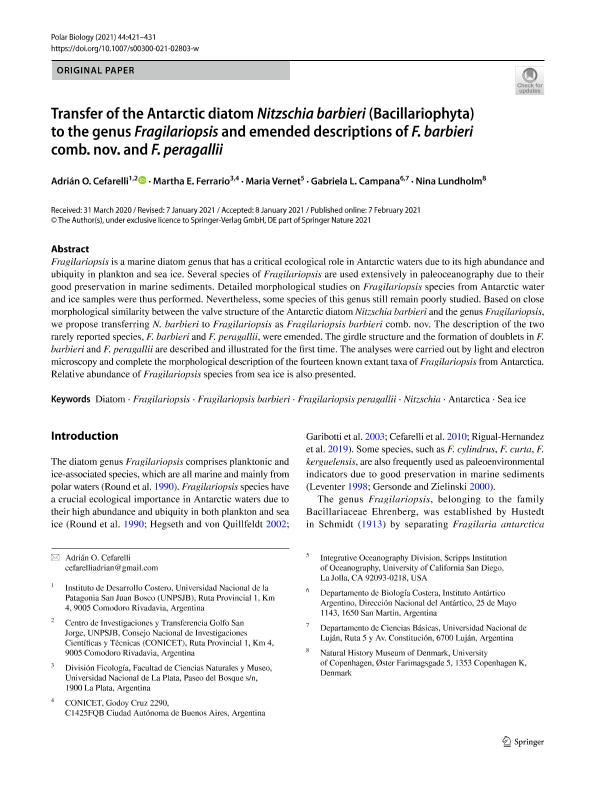Artículo
Transfer of the Antarctic diatom Nitzschia barbieri (Bacillariophyta) to the genus Fragilariopsis and emended descriptions of F. barbieri comb. nov. and F. peragallii
Cefarelli, Adrián Oscar ; Ferrario, Martha Elba
; Ferrario, Martha Elba ; Vernet, Maria; Campana, Gabriela Laura
; Vernet, Maria; Campana, Gabriela Laura ; Lundholm, Nina
; Lundholm, Nina
 ; Ferrario, Martha Elba
; Ferrario, Martha Elba ; Vernet, Maria; Campana, Gabriela Laura
; Vernet, Maria; Campana, Gabriela Laura ; Lundholm, Nina
; Lundholm, Nina
Fecha de publicación:
02/2021
Editorial:
Springer
Revista:
Polar Biology
ISSN:
0722-4060
Idioma:
Inglés
Tipo de recurso:
Artículo publicado
Clasificación temática:
Resumen
Fragilariopsis is a marine diatom genus that has a critical ecological role in Antarctic waters due to its high abundance and ubiquity in plankton and sea ice. Several species of Fragilariopsis are used extensively in paleoceanography due to their good preservation in marine sediments. Detailed morphological studies on Fragilariopsis species from Antarctic water and ice samples were thus performed. Nevertheless, some species of this genus still remain poorly studied. Based on close morphological similarity between the valve structure of the Antarctic diatom Nitzschia barbieri and the genus Fragilariopsis, we propose transferring N. barbieri to Fragilariopsis as Fragilariopsis barbieri comb. nov. The description of the two rarely reported species, F. barbieri and F. peragallii, were emended. The girdle structure and the formation of doublets in F. barbieri and F. peragallii are described and illustrated for the first time. The analyses were carried out by light and electron microscopy and complete the morphological description of the fourteen known extant taxa of Fragilariopsis from Antarctica. Relative abundance of Fragilariopsis species from sea ice is also presented.
Archivos asociados
Licencia
Identificadores
Colecciones
Articulos(SEDE CENTRAL)
Articulos de SEDE CENTRAL
Articulos de SEDE CENTRAL
Citación
Cefarelli, Adrián Oscar; Ferrario, Martha Elba; Vernet, Maria; Campana, Gabriela Laura; Lundholm, Nina; Transfer of the Antarctic diatom Nitzschia barbieri (Bacillariophyta) to the genus Fragilariopsis and emended descriptions of F. barbieri comb. nov. and F. peragallii; Springer; Polar Biology; 44; 2; 2-2021; 421-431
Compartir
Altmétricas



